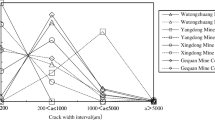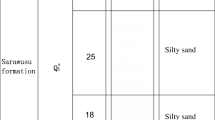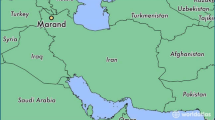Abstract
Grouting operation in karst aquifers is difficult due to the rapid underground water flow in large karst voids, which may scour and destroy the integrity of the slurry before solidification and, therefore, lead to a grouting curtain of poor quality. An important aspect of using grouting material in karst aquifers is to ensure that the slurry has a strong scour resistance and stability. For this purpose, a highly stable sandy cementitious grout is developed for karst aquifers, and the main components of this grout are cement, water, well-graded natural river sand, and sodium metaaluminate (NaAlO2, as the additive). The sand can improve the grain size distribution of the slurry and further enhance its scour resistance. To assess the mechanical performance of the newly presented grout, the bulk shrinkage rate, water-bleeding rate, setting time, weight retaining ratio, rheological properties, compressive strength and permeability are obtained by a series of indoor experiments. The results show that grout with an additive content of 1.0% has a very low bulk shrinkage rate of nearly 0% and a high weight retaining ratio of 85% under water scouring. All the physical and mechanical properties of the grout meet the requirements of curtain and consolidation grouting, including the requirements that the 28-day compressive strength of the grout reaches approximately 5–10 MPa and the permeability of the grout stone is less than 7.7 × 10–7 cm/s. Compared with clay–cement paste and cement–water–glass paste, using sandy cementitious grout can reduce the material costs by at least 43.1%. Finally, engineering applications in a dam foundation surrounded by karst aquifers are conducted, and the seepage problem is solved.








Similar content being viewed by others
References
Alzahrani MM, Maslehuddin M, Aldulaijan SU, Ibrahim M (2003) Mechanical properties and durability characteristics of polymer-and cement-based repair materials. Cem Concr Compos 25(4–5):527–537
Cui Q, Wu H, Xu Y, Shen S (2015) Construction measures to prevent hazards in karst cave ground under soft sand strata. Jpn Geotech Soci Spec Publ 1(7):52–55
Heidarzadeh M, Mirghasemi AA, Hussein MM (2014) Trialchemical grouting in filter materials at the Karkheh Dam site. Iran J Struct Eng Geo-Technol 4(1):29–33
Hu R, Wan J, Kim Y, Tokunaga TK (2017a) Wettability effects on supercritical CO2-brine immiscible displacement during drainage: pore-scale observation and 3D simulation. Int J Greenhouse Gas Control 60:129–139
Hu R, Wan J, Kim Y, Tokunaga TK (2017b) Wettability impact on supercritical CO2 capillary trap**: pore-scale visualization and quantification. Water Resour Res 53(8):6377–6394
Indraratna B, Israr J, Rujikiatkamjorn C (2015) Geometrical method for evaluating the internal instability of granular filters based on constriction size distribution. J Geotech Geoenviron Eng 141(10):04015045
Israr J, Israr J (2018) Experimental investigation and assessment of internal stability of granular filters under one-dimensional static and cyclic loading. Geotech Test J 41(1):103–116
Jain J, Narayanan N (2009) Analysis of calcium leaching behavior of plain and modified cement pastes in pure water. Cement Concr Comp 31(3):176–185
Johnson KS (2008) Gypsum-karst problems in constructing dams in the USA. Environ Earth Sci 53(5):945–950
Kazemian S, Huat BB, Arun P, Barghchi M (2010) A review of stabilization of soft soils by injection of chemical grouting. Aust J Basic Appl Sci 4(12):5862–5868
Labiadh MR, Ouezdou MB (2009) Characterization of waterproof-covering mortars on Ottoman monuments of ‘Ghar El Melh’. Constr Build Mater 23(1):423–433
Leo SJM (1995) Waterproofing of Portland cement mortars with a specially designed poly-acrylic latex. Cem Concr Res 25(3):503–509
Li W, Chen Y, Hu R, Zhou W, Zhou C (2016) A two-step homogenization-based permeability model for deformable fractured rocks with consideration of coupled damage and friction effects. Int J Rock Mech Min Sci 89:212–226
Li Y, Chen Y, Zhang G, Liu Y, Zhou C (2017) A numerical procedure for modeling the seepage field of water-sealed underground oil and gas storage caverns. Tunn Undergr Space Technol 66:56–63
Liu G, Sun WC, Lowinger SM, Zhang ZH, Huang M, Peng J (2019) Coupled flow network and discrete element modeling of injection-induced crack propagation and coalescence in brittle rock. Acta Geotech 14(3):843–868
Peng J, Wong LNY, The C (2017) Influence of grain size heterogeneity on strength and micro-cracking behavior of crystalline rocks. J Geophys Res Solid Earth 122(2):1054–1073
Pourchez J, Ruot B, Debayle J, Pourchez E, Grosseau P (2010) Some aspects of cellulose ethers influence on water transport and porous structure of cement-based materials. Cem Concr Res 40(2):242–252
Ramli M, Tabassi AA, Hoe KW (2013) Porosity, pore structure and water absorption of polymer-modified mortars: an experimental study under different curing conditions. Compos Part B 55:221–233
Sheng J, Huang T, Ye Z, Hu B, Liu Y, Fan Q (2019) Evaluation of van Genuchten-Mualem model on the relative permeability for unsaturated flow in aperture-based fractures. J Hydrol 9(576):315–324
Siswosoebrotho BI, Widodo P, Augusta E (2005) The influence of fines content and plasticity on the strength and permeability of aggregate for base course material. Proc Eastern Asia Soc Transp Stud 5:845–856
Sňuparek R, Soucek K (2000) Laboratory testing of chemical grouts. Tunn Undergr Space Technol 15(2):175–185
Sorochan EA, Tolmachev VV (2006) A base for building codes and construction method sinkarst-pronergions. Soil Mech Found Eng 43(6):216–220
Wang R, Ma D, Wang P (2015) Study on waterproof mechanism of polymer-modified cement mortar. Mag Concr Res 67(18):972–979
Yao C, Jiang Q, Shao J (2015) A numerical analysis of permeability evolution in rocks with multiple fractures. Transport Porous Med 108(2):289–311
Yao C, Shao J, Jiang Q (2017) Numerical study of excavation induced fractures using an extended rigid block spring method. Comput Geotech 85(12):368–383
Yao C, Shao JF, Jiang QH, Zhou CB (2019) A new discrete method for modeling hydraulic fracturing in cohesive porous materials. J Petrol Sci Eng 180:257–267
Ye Z, Liu H, Jiang Q, Liu Y, Cheng A (2017) Two-phase flow properties in aperture-based fractures under normal deformation conditions: analytical approach and numerical simulation. J Hydrol 545:72–87
Zhang G, Liu J, Li Y, Liang J (2017) A pasty clay-cement grouting material for soft and loose ground under groundwater conditions. Adv Cem Res 29(2):54–69
Zhang J, ** S, Zhang J (2009) The study on basic properties of polymer latex modified cement mortar. J Bei**g Univ Technol 35(8):1062–1068
Zhang X (2005) Discussion on the selection of grouting material for the curtain of karst tunnel. J Undergr Space Eng 3:432–434
Zhou JQ, Chen YF, Wang L, Cardenas MB (2019) Universal relationship between viscous and inertial permeability of geologic porous media. Geophys Res Lett 46(3):1441–1448
Zhou P, Zhang Y, Huang Z, Gao Y, Wang H, Luo Q (2017) Coal and gas outburst prevention using new high water content cement slurry for injection into the coal seam. Int J Min Sci Technol 27(4):669–673
Acknowledgements
The financial support from the National Natural Science Foundation of China (No. 51509022) and Natural Science Foundation of Hunan Province, China (No. 2019JJ50661), is gratefully acknowledged. Financial support was also provided by the Hunan Province Water Resources Technology Project of China (Nos. 2017-230-4 and XSKJ2018179-04).
Author information
Authors and Affiliations
Corresponding author
Additional information
Publisher's Note
Springer Nature remains neutral with regard to jurisdictional claims in published maps and institutional affiliations.
Rights and permissions
About this article
Cite this article
Li, Y., Zhang, G., Jiang, H. et al. Performance assessment of a newly developed and highly stable sandy cementitious grout for karst aquifers in China. Environ Earth Sci 79, 153 (2020). https://doi.org/10.1007/s12665-020-8894-8
Received:
Accepted:
Published:
DOI: https://doi.org/10.1007/s12665-020-8894-8




